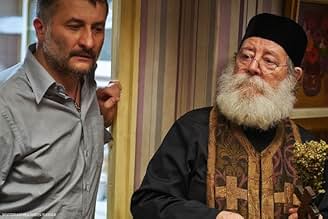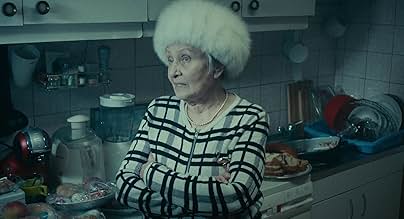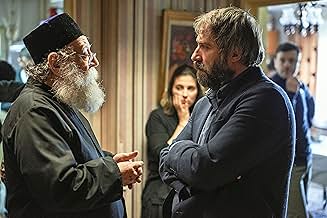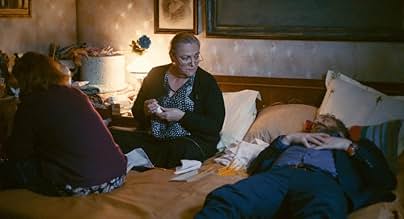Sieranevada
- 2016
- Tous publics
- 2h 53min
NOTE IMDb
7,3/10
6 k
MA NOTE
Ajouter une intrigue dans votre langueCenters around a family gathering on the anniversary of a patriarch's recent death.Centers around a family gathering on the anniversary of a patriarch's recent death.Centers around a family gathering on the anniversary of a patriarch's recent death.
- Réalisation
- Scénario
- Casting principal
- Récompenses
- 21 victoires et 21 nominations au total
Avis à la une
Family drama has never portrayed this good. You are invited into this family's house during the aftermath of a funeral in the wintertime. It gets very intense.
With a delay of three years I managed to see Cristi Puiu's 'Sieranevada', a film that I had read and heard much about. Three years are certainly not enough for a 'historical' perspective but they are enough to better place the film in the context of what happened in the Romanian cinema before and after it and to understand the rather heated disputes it has created among critics and viewers. The film is indeed complex but also complicated, interesting but also long, providing many reasons to like it but also a few that can leave viewers from different categories of audience confused or dissatisfied.
The opening scene looks like a quote from the other new wave, the French one. A camera set up at a fixed point shoots for a few minutes a Bucharest intersection, with the chaos, agglomeration and noise that we know. The characters of the film, which we do not distinguish, are still silhouettes among the many that make up this hubbub. We'll follow two of them in a car that drives them for several minutes to the apartment where most of the action of the film is taking place. There they join the family reunited for the commemoration meal (following a regional traditional custom!) of the head of the family, who had died 40 days ago. For two hours, almost in real time, we will witness the ceremony, discussions, conflicts of a family large enough to include some of the characters known to those living in Romania today - the physician who abandoned his job for a more profitable trade , a young supporter of conspiracy theories, the older generation of those economically affected by the transition who try to adapt with little success to the new realities, a nostalgic for the communist regime, the young woman with dubious connections and habits including suspected drug use, the priest who is late due to a busy schedule because the religious business is going full on, couples in crisis or marriages already broken up. A beautifully constructed mosaic, a diverse and tormented world. And yet, they will also meet at future occasions or holidays, because family and friendship ties, together with adherence to a religious tradition that is not forgotten or abandoned, are the only links that somehow hold together the Romanian social fabric. These and maybe also the humor.
It is worth watching how Cristi Puiu and his cinematographer Barbu Balasoiu work with the camera. Sometimes the frame is fixed, most often mobile, it follows the point of view of one character or another, giving the feeling of a claustrophobic maze in the 3 or 4 room apartment where the action takes place. It is a sensation programmatically induced to the spectators, when we are outside the apartment we are dealing with the same chaos, with the same maze of human relations in crisis, only that the spaces are more open, but the atmosphere is frozen. The semi-darkness predominates and makes the film not easy to watch, also the sound capture is not optimal, but I think that the reason does not lie in technical issues but in the decisions of the director. Acting is superb, mentioning any name will do an injustice to all the other. The film captivated me and I did not feel or resempt the length at any time. But I can understand those who did not like the duration, or had difficulties in tracking the image or voices, because Cristi Puiu did not aim the aesthetics but wanted to convey ideas and sensations. Foreign viewers will have difficulties understanding many nuances, and those in Romania who are tired or exasperated by the mirrors that some of the contemporary directors put in front of them also have reasons to be upset. As much as I liked the movie, I believe that the minimalist formula has exhausted its resources and has certainly lost the elements of surprise and novelty. That's why I'm not surprised that the movie was ignored in the Cannes palmares. In 2005, Cristi Puiu made one of the first remarkable films of the new wave of Romanian cinema - 'The Death of Mr. Lazarescu'. 'Sieranevada' made in 2016 may be one of the last outstanding films of this wave.
The opening scene looks like a quote from the other new wave, the French one. A camera set up at a fixed point shoots for a few minutes a Bucharest intersection, with the chaos, agglomeration and noise that we know. The characters of the film, which we do not distinguish, are still silhouettes among the many that make up this hubbub. We'll follow two of them in a car that drives them for several minutes to the apartment where most of the action of the film is taking place. There they join the family reunited for the commemoration meal (following a regional traditional custom!) of the head of the family, who had died 40 days ago. For two hours, almost in real time, we will witness the ceremony, discussions, conflicts of a family large enough to include some of the characters known to those living in Romania today - the physician who abandoned his job for a more profitable trade , a young supporter of conspiracy theories, the older generation of those economically affected by the transition who try to adapt with little success to the new realities, a nostalgic for the communist regime, the young woman with dubious connections and habits including suspected drug use, the priest who is late due to a busy schedule because the religious business is going full on, couples in crisis or marriages already broken up. A beautifully constructed mosaic, a diverse and tormented world. And yet, they will also meet at future occasions or holidays, because family and friendship ties, together with adherence to a religious tradition that is not forgotten or abandoned, are the only links that somehow hold together the Romanian social fabric. These and maybe also the humor.
It is worth watching how Cristi Puiu and his cinematographer Barbu Balasoiu work with the camera. Sometimes the frame is fixed, most often mobile, it follows the point of view of one character or another, giving the feeling of a claustrophobic maze in the 3 or 4 room apartment where the action takes place. It is a sensation programmatically induced to the spectators, when we are outside the apartment we are dealing with the same chaos, with the same maze of human relations in crisis, only that the spaces are more open, but the atmosphere is frozen. The semi-darkness predominates and makes the film not easy to watch, also the sound capture is not optimal, but I think that the reason does not lie in technical issues but in the decisions of the director. Acting is superb, mentioning any name will do an injustice to all the other. The film captivated me and I did not feel or resempt the length at any time. But I can understand those who did not like the duration, or had difficulties in tracking the image or voices, because Cristi Puiu did not aim the aesthetics but wanted to convey ideas and sensations. Foreign viewers will have difficulties understanding many nuances, and those in Romania who are tired or exasperated by the mirrors that some of the contemporary directors put in front of them also have reasons to be upset. As much as I liked the movie, I believe that the minimalist formula has exhausted its resources and has certainly lost the elements of surprise and novelty. That's why I'm not surprised that the movie was ignored in the Cannes palmares. In 2005, Cristi Puiu made one of the first remarkable films of the new wave of Romanian cinema - 'The Death of Mr. Lazarescu'. 'Sieranevada' made in 2016 may be one of the last outstanding films of this wave.
The long demanding exhausting movie is permeated with Eastern European scent. The legacy of the poor relatives and backyards of Europe is recognisable in every excruciating detail for those who had grown up there. Smallish crowded kitchens with dilapidated cabinets. Worn out light switches which were the same in Bucharest or Kyiv. Long tables if unfolded occupy the whole living room and you squeeze yourself out to get to your seat. Low-waged doctors who downshift to medical equipment salesmen. And the family saga which unfolds painfully slow and mesmerisingly absorbing. Once you are on the other side of the film equator you cannot but start guessing what the hell is going on in this family. Cutting of the movie is so unorthodox that you start wondering if there had been any cutting at all.
I don't know why but I found this movie really good. It resembled to the the high school book I had to read in my time, Enigma Otiliei or like Morometii book & screen play.
Like all Romanian movies, it has that drama-parody of being a post-communist member; like all the good post-revolution movies. This movie is from the same category. But! And there's a huge "But". This movie has a really tangled and well-structured story line. The characters are really complex. I loved the "detailed" small-talks that took place alongside the main story. Also, like many Romanian families, you have that huge abundance of relatives that you have to deal with. You have that "It's family!" saying that your mother told you every time you couldn't stand your cousin when you were little. Also, all the actors seem to play their parts really well. I've seen almost all the good Romanian movies and I can say that these are some hardcore actors. They fit so well with their characters and their performance is almost perfect.
Yes, it has the downsides that all Romanian movies have: the static scenes and the bad sound quality. You have to have subtitle otherwise, most of the time, if you are Romanian, you won't understand a word.
All of this being said, enjoy! It's just a pure South-Eastern Week-end story event!
Throughout history, the seventh art, with its hundred-year history, has seen many twists and turns, it has been taken from various small cultural and artistic movements until a large number of them carry the history of cinema on their shoulders, various companies and their constant policies, geographical determinism and various wars have subjected this field to it.
One of these factors is the various cultural movements.
Whether they like it or not, movements are always happening throughout the history of art, even in other human lives, sometimes with the speed of lightning and sometimes like the last turbulent sea.
The Romanian New Wave is one of those cultural movements, especially in film, that moves slowly in terms of its connection to the plots and internal atmosphere of its films, but like the last ones, it is angry, roaring and criticizing.
The theme of this wave, which began in the first decade of the 21st century, is to slowly portray social events to us, and it is so realistic that we watch scenes from last night's party with our relatives and relatives, or, for example, a scene of something that happened to a sister or brother, that's how it is and does it. There is a period of cinema in between that includes storytelling in the heart of simple everyday events and invites us to identify with them to such an extent, but perhaps what makes Romanian New Wave cinema special is its closeness to realism and its fearlessness, and it can be more glorious in stories that can be in real cinema.
The plot is probably less popular with cinema audiences because of the very area in which it shows its films, directors whose films are similar to theirs, both in terms of form and content and narrative, can be found in corners of world cinema - all of which are separated from mainstream cinema, with slow, bold plots and what might happen. They bring their script to the film, which truly shapes the entirety of Romanian New Wave films, with these tools and creative texts and subtexts, in the following years, a step towards establishing this medium in terms of the problems of living conditions, political and social conditions, problems of family life and especially and the exploration of human morality.
Romanian New Wave cinema is the movement of the camera on the hand in the hallways and rooms of apartment buildings in order to show everyday events, the cinema is the cinema of showing the chatter and conversation of people around the dinner table, the cinema of rape of the individual and the way he deals with this issue, it is a film that every country can understand because it cannot understand a person at all because it makes a person more.
Minimal space, bright colors and dark nights, scripts full of dialogue and monologues, and the camera being in the flow and instability of events, whose very instability has also created stability for itself.
Siranvada, along with other important works by several directors of this movement, is one of the most seen works of this wave, along with masterpieces such as "4 Months, 3 Weeks and 2 Days" or "Graduation Party", both of which can be attributed to Cristian Mongeau, who was made by Cristian Puio, and both of these directors had an impact on the formation of this movement.
Siranvada falls short of the important works of the Romanian New Wave because, in addition to being an average and correct film, it also has the theme and cinema of the New Wave within it, and with its minimalist atmosphere, it also gives you a special mood, tells the stories of different people and always tells about different arguments and discussions, although you may use different plots. It will captivate the audience.
There are stories of different people who have gathered together on the occasion of the fortieth anniversary of the death of one of their relatives and want to hold a party...
One of these factors is the various cultural movements.
Whether they like it or not, movements are always happening throughout the history of art, even in other human lives, sometimes with the speed of lightning and sometimes like the last turbulent sea.
The Romanian New Wave is one of those cultural movements, especially in film, that moves slowly in terms of its connection to the plots and internal atmosphere of its films, but like the last ones, it is angry, roaring and criticizing.
The theme of this wave, which began in the first decade of the 21st century, is to slowly portray social events to us, and it is so realistic that we watch scenes from last night's party with our relatives and relatives, or, for example, a scene of something that happened to a sister or brother, that's how it is and does it. There is a period of cinema in between that includes storytelling in the heart of simple everyday events and invites us to identify with them to such an extent, but perhaps what makes Romanian New Wave cinema special is its closeness to realism and its fearlessness, and it can be more glorious in stories that can be in real cinema.
The plot is probably less popular with cinema audiences because of the very area in which it shows its films, directors whose films are similar to theirs, both in terms of form and content and narrative, can be found in corners of world cinema - all of which are separated from mainstream cinema, with slow, bold plots and what might happen. They bring their script to the film, which truly shapes the entirety of Romanian New Wave films, with these tools and creative texts and subtexts, in the following years, a step towards establishing this medium in terms of the problems of living conditions, political and social conditions, problems of family life and especially and the exploration of human morality.
Romanian New Wave cinema is the movement of the camera on the hand in the hallways and rooms of apartment buildings in order to show everyday events, the cinema is the cinema of showing the chatter and conversation of people around the dinner table, the cinema of rape of the individual and the way he deals with this issue, it is a film that every country can understand because it cannot understand a person at all because it makes a person more.
Minimal space, bright colors and dark nights, scripts full of dialogue and monologues, and the camera being in the flow and instability of events, whose very instability has also created stability for itself.
Siranvada, along with other important works by several directors of this movement, is one of the most seen works of this wave, along with masterpieces such as "4 Months, 3 Weeks and 2 Days" or "Graduation Party", both of which can be attributed to Cristian Mongeau, who was made by Cristian Puio, and both of these directors had an impact on the formation of this movement.
Siranvada falls short of the important works of the Romanian New Wave because, in addition to being an average and correct film, it also has the theme and cinema of the New Wave within it, and with its minimalist atmosphere, it also gives you a special mood, tells the stories of different people and always tells about different arguments and discussions, although you may use different plots. It will captivate the audience.
There are stories of different people who have gathered together on the occasion of the fortieth anniversary of the death of one of their relatives and want to hold a party...
Le saviez-vous
- AnecdotesThe title, deliberately misspelled, is a parody of esoteric film titles and does not refer to anything specific.
- Crédits fousSilvia Nastase is credited in the opening titles but not in the end credits.
- ConnexionsReferences Blanche-Neige et les Sept Nains (1937)
- Bandes originalesSymphony in C minor J-C 9, I. Allegro
Composed by Giovanni Battista Sammartini
Performed by Aradia Ensemble
Conducted by Kevin Mallon
Courtesy of Naxos Deutschland GmbH
Meilleurs choix
Connectez-vous pour évaluer et suivre la liste de favoris afin de recevoir des recommandations personnalisées
- How long is Sieranevada?Alimenté par Alexa
Détails
- Date de sortie
- Pays d’origine
- Site officiel
- Langue
- Aussi connu sous le nom de
- Сьєраневада
- Lieux de tournage
- Strada Ionel Perlea, Bucarest, Roumanie(Opening scene: Lary's street)
- Sociétés de production
- Voir plus de crédits d'entreprise sur IMDbPro
Box-office
- Budget
- 1 400 000 € (estimé)
- Montant brut mondial
- 247 196 $US
- Durée2 heures 53 minutes
- Couleur
- Rapport de forme
- 1.85 : 1
Contribuer à cette page
Suggérer une modification ou ajouter du contenu manquant

Lacune principale
By what name was Sieranevada (2016) officially released in India in English?
Répondre






















